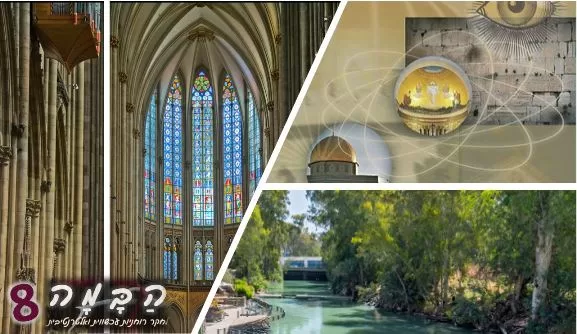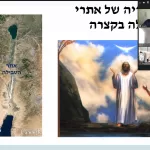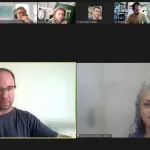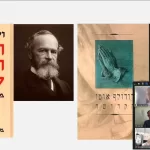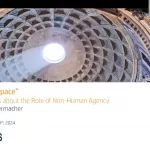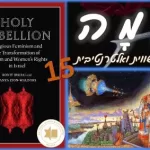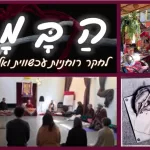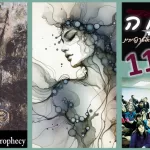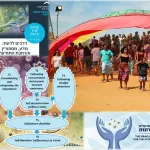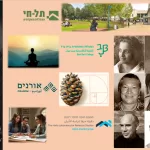יום ג', י"ב בסיוון תשפ"ד, 18 ביוני 2024, מהשעה 10:30 עד 12:00
למידע כללי על 'הבמה' – הקישו כאן.
לסרטון המפגש – גלגלו למטה.
חלק א: הצגת מחקרים אקדמיים
חלק א: הצגת מחקרים אקדמיים
על המרצה
Martin Radermacher (Dr. phil.) is a scholar of comparative religion at the Center for Religious Studies (CERES) at Ruhr University Bochum with a research focus on contemporary Christianities in Europe and North America and a special interest in the relationships of space/materiality and religion. He has conducted research as a visiting scholar at Columbia University (New York City) and the Center of Theological Inquiry (Princeton, NJ). His book Devotional Fitness: An Analysis of Contemporary Christian Dieting and Fitness Programs was published in 2017. He has published peer-reviewed articles in, e.g., Material Religion, the Zeitschrift für Religionswissenschaft, the Journal of Religion and Popular Culture, Entangled Religions, and the Journal of Religion in Europe.
martin.radermacher@rub.de
רפרנס
Radermacher, Martin (2022): Religious Authority in Evangelical, Charismatic, and Pentecostal Christianities. Reflections about Concepts, Methods, and the Role of Non-Human Agency in Authority Relations. In: Research in the Social Scientific Study of Religion 32, 616–633.
לינקים/ קבצים
להורדת המאמר – הקישו כאן (נדרשת סיסמה).
על המרצה
ד"ר ליאור חן הוא אנתרופולוג המתמחה בהיבטים תרבותיים ופוליטיים של מקומות קדושים. כיום מכהן חן כמנהל האגף למחקר חברתי של רשות הטבע והגנים.
תקציר
המחקר בוחן את ההתהוות המחודשת של שלושה מקומות קדושים ב"ארץ הקודש" בעשורים האחרונים. שלושת המקומות הם אתרי טבילה הנמצאים לאורך נהר הירדן ונקשרים להטבלת ישוע. האתרים, בתניה מעבר לירדן, ירדנית וקצר אליהוד, נמצאים בחצי המאה האחרונה בתהליך שינוי מתמשך. על בסיס ממצאי עבודת שדה שערכתי בין השנים 2013-2017 אבקש לנתח את תהליך התהוות האתרים ואת מעורבות שושביני האתרים בתהליך זה בעזרת המושגים 'אותנטיות' ו'אותנטיזציה'. אשאל מה תפקידה של "האותנטיות" בתהליך ההתהוות המחודשת של האתרים וכיצד פועלים סוכני כל אתר במטרה להקנות "אותנטיות" לאתר שאליו הם קשורים. כמענה על שאלות אלו אטען כי תהליכי ההתהוות של שניים מהאתרים, בתניה מעבר לירדן וירדנית, תואמים במידה רבה לתצורות האותנטיזציה, הקרה והחמה, אותם הציעו כהן וכהן (Cohen and Cohen 2012). אולם, ביחס לאתר השלישי, קצר אליהוד, אציע כי שתי התצורות הקיימות בספרות אינן מסבירות את תהליך התהוותו ועל כן אבקש להצביע על מודל חדש. בעוד שתי תצורות האותנטיזציה הראשונות מבטאות תהליכים המתבססים על מאמץ מכוון של מנהלי האתרים, תהליך האותנטיזציה של האתר השלישי, הרבה בשל מיקומו הרגיש של האתר, הוא תהליך פאסיבי יותר. אכנה תהליך זה בשם הפרדוקסלי "אותנטיזציה של חוסר נגיעה".
רפרנס
חן, ל', הקר, ע', שטדלר, נ' (עורכים). מקומות קדושים בארץ הקודש – מבט אתנוגרפי. למדא עיון, הוצאת הספרים של האוניברסיטה הפתוחה.
על המרצה
ד"ר זאב בן אריה כתב דוקטורט במדעי הדתות אוניברסיטת חיפה. הוא מורה דרך, סופר, יליד 1961.
תקציר
לתקציר בעברית – הורידו את קבצי המבואות שלהלן.
Building upon the notion that "Man is the template of his native landscape," it can be inferred that the potential for religious experience in a Sacred Place is intrinsically tied to its patterns and structure. In light of this understanding, the primary objective of this study is to highlight the possibility of religious experiences in individuals who visit what can be referred to as "Charismatic Sacred Places." Within the study, a clear distinction is made between ordinary Sacred Places, constructed according to predefined patterns, and Charismatic Sacred Places, which are intentionally designed with a certain degree of freedom and possess qualities that captivate the imagination and exude charisma. It is important to note that not every place labeled as "Sacred" genuinely embodies the essence of the Sacred, as discussed within the context of this study. The study is rooted in understanding the Sacred, as religious scholars like William James, Rudolf Otto, and Mircea Eliade explained. From this perspective, religious comprehension constitutes a distinctive experience that transforms an individual's awareness and consciousness, shifting them from the profane and ordinary to the realm of the Sacred and even the mystical. To establish this understanding, the study draws from disciplines such as the psychology of religion, transpersonal psychology, and comparative religions. The study proposes that visiting places constructed according to specific principles can facilitate religious experiences in certain individuals (although not all). The mechanisms behind this phenomenon are explored through the lens of the phenomenology of perception. Human perception, which acknowledges the objective existence of reality and our subjective interpretation of it, enables religious and aesthetic experiences. To substantiate this argument, the study draws from fields such as art criticism, phenomenology, environmental psychology, and sacred architecture. Dual perception plays a crucial role in how we perceive, interpret, and sanctify a place. Numerous studies investigate the connection between individuals and their surroundings, exploring how places can influence people. By recognizing the principles of environmental psychology, which assert that our environment impacts us and shapes our sense of self, the study lays the groundwork for its theories. These theories examine the presence of Sacredness Generators within Charismatic Sacred Places, considering their arrangement, structure, and the way we perceive them. To support these arguments, the study references research in sacred architecture, art, environmental psychology, and the relationship between individuals and their environment. It reveals the existence of four generators of Sacredness within human perception and the structure of a place: the Generator of Unifying Duality, the Generator of the Sublime Unusual, the Generator of the Connecting Center, and the Generator of Fractal Complexity. These generators play a significant role in evoking religious experiences in individuals who visit charismatic Sacred Places. They operate within the framework of human perception during encounters with places that are constructed based on the principles associated with the generators. The study’s theoretical chapters support the existence of these generators in the context of pilgrimages to Sacred Places. The study further explores the distinction between conventional Sacred Places, which are often intertwined with nationalism, tradition, and politics, and charismatic Sacred Places. Charismatic Sacred Places are perceived through an individual process that transcends history and culture, offering a universal experience. The encounter with the Sacred involves a transformative process that entails surrender to a numinous presence, leading to acceptance, openness, and a shift in awareness and consciousness. This experience entails a negation of the ego and a connection to the irrational. Building upon theories of peak and plateau experiences by Avraham Maslow and the process of individuation and the self by Carl Jung, the study delves into mystical religious experiences as described in religious studies and transpersonal psychology. It also expands on William James' stages of religious experience, Rudolf Otto's concept of the numinous, and Mircea Eliade's theories on the Sacred and profane. Eliade's theories are viewed as modes of perception rather than an ontological external reality, as explained by Rennie. The study is divided into several parts, with the first part (Chapter 2) focusing on the nature of the Sacred and religious experiences in individuals. The second part (Chapter 3) explores human perception of a place, drawing from environmental psychology studies. It expands on the patterned way we perceive reality and delves into symbols, archetypes, the reflection of the Sacred in nature, and the influence of sacred architecture. To elucidate how external physical reality can possess internal spiritual meaning, the study draws examples from artistic aesthetic experiences found in art studies, particularly the theories of Wassily Kandinsky and others. The third part (Chapter 4) delves into the process of visiting a Sacred Place, taking into account the influence of factors such as silence, privacy, and physical presence (e.g., water or caves). It examines individual visits to Sacred Places that offer moments of silence and presence, allowing for transformative experiences. The emotional impact of visiting a place, the order of the visit, accompanying actions, preparation, and narratives all contribute to religious experiences. The study likens visiting a Sacred Place to the hero's journey as described by Joseph Campbell, suggesting that a genuine experience has the power to transform the visitor. The subsequent chapters explore the workings of the four generators, providing examples from renowned Charismatic Places in Israel. In summary, the study concludes with a reference to research on religious experiences in the Israeli context, highlighting the importance of the visiting process. The summary addresses potential counterarguments and reiterates the integrated workings and characteristics of the generators. The study ultimately suggests avenues for further research in this field. Chapter 5 focuses on the Generator of Unifying Duality, examining its connection to the dual structure of humans (body and soul) and the dual nature of human perception. The chapter suggests that perceiving external dualities in a unifying manner allows for the reconciliation of opposing elements within oneself, ultimately leading to transpersonal or religious experiences. Examples include sites like Nabi Shuayb, Rujum Al-Hiri Megalithic Stone Circle, Mount Tabor Church, the Church of the Holy Sepulcher, the Wailing Wall, and the Dome of the Rock. Chapter 6 introduces the Sublime Unusual Generator, which operates through human perception and the establishment of orientation within a particular space. It captures the mind's attention and provides the necessary stimulation for transitioning between levels of existence and experience. Extraordinary elements like height, size, and spatial arrangements contribute to creating mental states conducive to religious experiences. Examples include the exceptional size of the stones in the Wailing Wall, the exceptional beauty of the Dome of the Rock, and the extraordinary narratives surrounding the miracle at Rabbi Meir's tomb. Chapter 7 explores the Fractal Complexity Generator, which is characteristic of Charismatic Sacred Places. The chapter expands on the generator's relationship with archetypes, patterns of perception in the subconscious, hierarchies, the world image (Imagio mundi), sacred geometry, and borders. Examples from various sacred sites, including the Dome of the Rock, Baha'i Gardens in Acre, Sufi Zawiya in Acre, the Wailing Wall, and Rabbi Meir's tomb, illustrate the concept of fractal complexity. Chapter 8 focuses on the Connecting Center Generator, which relates to the concept of axis mundi (world axis) described by Eliade. It explains that the true meaning of the center is not an ontological external reality but a phenomenological perception that concentrates thought, consciousness, and presence. The chapter provides examples from the Church of the Holy Sepulcher, the Zawiya in Acre, and the Bahá'í Temple and Gardens in Acre to demonstrate the operation of the Connecting Center Generator. Additionally, the study includes three additional independent chapters. Chapter 9 explores other generators of Sacredness associated with visiting holy places, emphasizing conditions such as silence, privacy, and physical elements like water or caves. Chapter 10 discusses the charismatic planning of Sacred Places and presents examples of the planning process, featuring the works of Antonio Barluzzi in designing the Mount Tabor Church and Omar Reiss's contributions to the Zawiya in Acre. The appendix chapter specifically relates to Sacred Places in Judaism and the State of Israel.
קבצים
להורדת פרקי המבוא של עבודת המחקר – הקישו כאן.
לספר המחקר – הקישו כאן.
האתר של זאב בן אריה: https://tarbuyotolami.com
סרטון המפגש (ותודה לנטליה גרויסמן על העריכה!)

